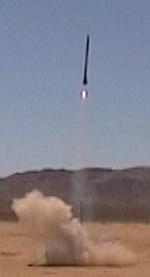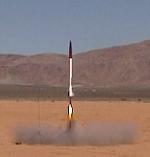Perchlorathon June 2004
June 2004
/ Lucerne Dry Lake
2 flights, 2150 N-sec burned
I had been making propellant for a few months in the chemistry lab at school, and my teacher Mr. Ause really wanted to come see it in action. He finally got his chance when school let out. Along with the rest of the flights that happened, I static burned two blue G motors for him. The day itself was beautiful, with light winds and moderate temperatures for June.
Flight 1: Arcas, Kosdon K295
Well, I resolved to get the Arcas out at the beginning of the year and fly her on a K550W. Due to certain circumstances (hint: J570W, separation, and yokels with shotguns!), that flight never materialized. I couldn't attend February or March launches (school musical) and April I ran out of time (finicky hybrid pad). May I wanted to take a break from complex rockets, and finally June rolled around. I had an unusual opportunity, though. I recently got ahold of some 1700 Ns 76mm hardware. What better rocket to try it out in? I loaded up the case with 1 grain of fast propellant and one grain of black smokey propellant, christened the motor a K300, and shoved it in the back of the Arcas. With easy prep, aided by a nice new G10 altimeter board, we had the rocket on the pad by 10:00. A quick countdown and the button was pushed. The rocket sat and thought about it for a second, then it began. Orange flame spewed from the base of the rocket as the motor pressurized. The fast grain lit first and took the rocket off the pad s-l-o-w-l-y (4.5 gees according to the ARTS) on its characteristic yellow tongue of flame. At 54 feet in the air (ARTS data is great!), the motor POPPED and the smoky grain kicked in. The acceleration increased to a max of 6 gees and the rocket continued its ride up to apogee, sputtering and spewing out orange flame and black smoke the whole way. It probably wasn't the most effective use of propellant, but let me try to describe to you the reaction I got from everyone at the site: WOW! COOL! WAY COOL! After burnout, the 29mm smoke element provided plenty of tracking smoke up to apogee, through successful drogue ejection, and also on the return trip down for about 700 feet. Main ejection was spot on at 1000 feet, and the ARTS backup went off at 750 feet as planned. Perfection!
Altitude: 4,543 ft
Flight 2: Jaguar, Kosdon I130
For the first flight of the Jaguar, I wanted to push it high, but not fast. The c-slot load for the 640 case seemed to be just the ticket. Prep was easy, using the spacious altimeter bay, and the rocket was quickly on the pad with an igniter installed. A well-known (infamous, even) flyer kept telling me how the motor was going to blow up since it was a c-slot; I think he was just bitter that I like Frank's motors better than his. At zero, the rocket ignited and lifted smartly off the rail. It wagged its tail a few times on the way up, and coasted up to apogee. The drogue appeared waaaaay up there, and the rocket fell for a long time to 1000 feet, where the main deployed. Good first flight!
Altitude: 5,460 ft

others: preflight | with me looking odd
video


